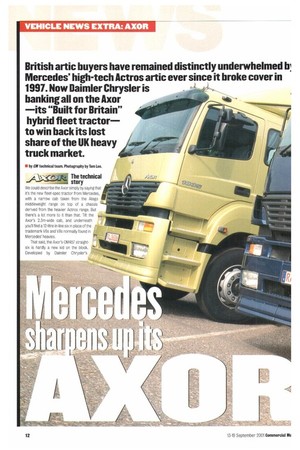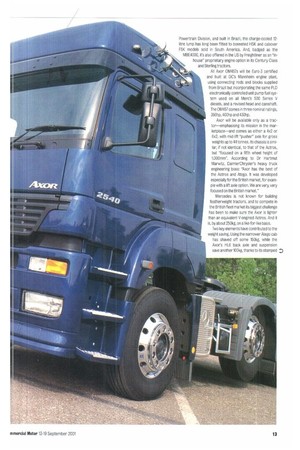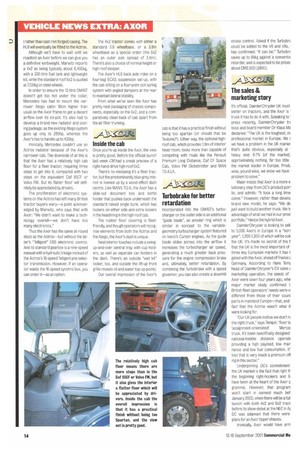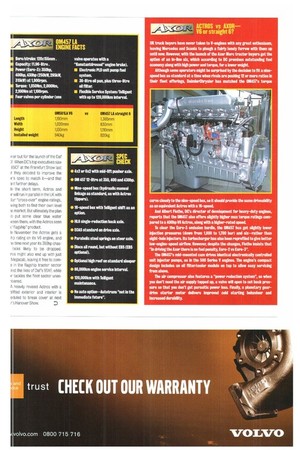British artic buyers have remained distinctly undenvhelmedk Mercedes' high-tech Actros
Page 12

Page 13

Page 14

Page 15

Page 16

If you've noticed an error in this article please click here to report it so we can fix it.
artic ever since it broke cover in 1997. Now Daimler Chrysler is banking all on the Axor its "Built for Britain"
hybrid fleet tractor—
to win back its lost share of the UK heavy truck market.
ol by CM technical town. Photography by Tom Lee.
The technical story
We could describe the Axor simply by saying that it's the new fleet-spec tractor from Mercedes, with a narrow cab taken from the Atego middleweight range on top of a chassis derived from the heavier Actros range. But there's a lot more to it than that. Tilt the Axor's 2.3m-wide cab, and underneath , you'll find a 12-litre in-line six in place of the trademark Ves and V8s normally found in Mercedes heavies.
That said, the Axor's 0M457 straight16 six is hardly a new kid an the block. Developed by Daimler Chrysler's
Powertrain Division, and built in Brazil, the charge-cooled 12litre lump has long been fitted to bonneted HSK and cabover FSK models sold in South America. And, badged as the
NMBE4000, tt's also offered in the US by Freightliner as an 'Inhouse" proprietary engine option in tts Century Class and Sterling tractors. All Axor 0M457s will be Euro-3 certified and built at DC's Mannheim engine plant, using connecting rods and blocks supplied from Brazil but incorporating the same PLD electronically controlled unit pump fuel system used on all Merc's 500 Series V diesels, and a revised head and camshaft. The 0M457 comes in three nominal ratings, 350hp, 400hp and 430hp.
Axor will be available only as a tractor—emphasising its mission in the mar
ketplace and comes as either a 4x2 or 6x2, with mid-lift "pusher" axle for gross weights up to 44 tonnes. Its chassis is similar, if not identical, to that of the Actros, but 'focused on a fifth wheel height of 1,000mm". According to Dr Hartmut Marwitz, DaimlerChrysler's heavy truck engineering boss: "Axor has the best of the Actros and Atego. It was developed especially for the British market, for example with a lift axle option. We are very, very focused on the British market."
Mercedes is not known for building featherweight tractors, and to compete in the British fleet market its biggest challenge has been to make sure the Axor is lighter than an equivalent V-engined Actros. And is, by about 250kg, on a like-for-like basis. Two key elements have contributed to the weight saving. Using the narrower Atego cab has shaved off some 150kg, while the Axor's FIL6 back axle and suspension save another 100k, thanks to its stamped
( rather than cast iron forged) casing. The HL6 will eventually be fitted to the Actros.
Although we'll have to wait until we roacttest an Axor before we can give you a definitive kerbweight, Marwitz reports a 4x2 as being typically about 6,400kg, with a 300-litre fuel tank and lightweight kit, while the standard-roof 6x2 is quoted at 7.100kg on steel wheels.
In order to ensure the 12-litre 0M457 doesn't get too hot under the collar, Mercedes has had to mount the narrower Atego cabin 18cm higher than usual on the Axor frame to get a decent airflow over its six-pot. It's also had to develop a brand new radiator and cooling package, as the existing Atego system goes up only to 280hp, whereas the Axor's has to handle Lip to 430hp.
Ironically, Mercedes couldn't use an Actros radiator because of the Axor's narrower cab. The downside of all this is that the Axor has a relatively high cab floor for a fleet tractor, requiring three steps to get into it, compared with two steps on the equivalent Daf 85CF or Volvo FM. But its flatter floor will definitely be appreciated by drivers.
The proliferation of electronic systems on the Actros has left many British tractor buyers wary—a point acknowledged by Marwitz, who says that with Axor: 'We didn't want to make a technology overkill—we don't have too many electronics.'
Thus the Axor has the same all-round discs as the Actros—but without the latter's "Telligent" EBS electronic control, And its standard gearbox is a nine-speed manual with a hydraulic linkage instead of the Actros's 16-speed Telligent pre-selector transmission. However, if an operator wants the 16-speed synchro box, you can order it—as an option. The 4x2 tractor comes with either a standard 3.6 wheelbase, or a 3.9m wheelbase as a special order (the 6x2 has an outer axle spread of 3.9m). There's also a choice of normal-height or high-roof sleeper.
The Axor's HL6 back axle rides on a four-bag ECAS suspension set-up, with the cab sitting on a four-point coil spring system with angled dampers at the rear to maintain lateral stability.
From what we've seen the Axon has pretty neat packaging of chassis compo nents, especially on the 6x2, and a comparatively clean back of cab apart from the air filter trucking.
Inside the cab
Once you're up inside the Axor, the view is pretty good. Before the official launch last week CM had a sneak preview of a right-hand-drive high-roof 6x2.
There's no mistaking it's a fleet tractor, but the predominantly blue-grey interior is livened up by a wood-effect dash centre. Like MAN's TG-A, the Axor has a slide-out document box and bottle holder that pushes back underneath the standard raised single bunk, which has lockers on either side and extra lockers in the headlining in the high-roof cab.
The rubber floor covering is fleetfriendly, and though operators will recognise elements from both the Actros and the Atego, the Axor's dash is unique.
Neat interior touches include a swingup-and-over central tray with cup holders, as well as separate can holders in the dash. There's an outside 'wet kit" locker, too, and outside the lift-up front grille reveals oil and water top-up points.
Our overall impression of the Axor's cab is that it has a practical finish without being too spartan (or should that be Teutonic?). Either way, the optional highroof cab, which provides 1.9m of interior head room, looks more than capable of competing with rivals like the Renault Premium Long Distance, Oaf CF Space Cab, Volvo FM Globetrotter and MAN TG-A LX.
Turhohrake for better retardation
Incorporated into the 0M457's turbocharger on the outlet side is an additional "guide blade", an annular ring which is similar in concept to the variablegeometry turbocharger system featured on Iveco's Cursor engines. As the guide blade slides across into the airflow it increases the turbocharger air speed, generating a much greater back pressure for the engine compression brake and, ultimately, better retardation. By combining the Turbobrake with a speed governor, you can also create a downhill cruise control. Asked if the TurbobN could be added to the V6 and V8s, I has confirmed: "It can be." Turbobr saves up to 85kg against a convent° retarder, and is expected to be pricec about DM2,500 (.£800).
The sales & marketing story
It's official. DaimlerChrysler UK must better on tractors, and the Axor is 1 truck it has to do it with. Speaking to press recently, DaimlerChrysler tn boss and board member Dr Klaus Ma declared: "The UK is the toughest, ml professional market in Europe. We we have a problem in the UK markei that's quite obvious, especially at ' heavy end: 6-7% [of the market] approximately nothing, far too little the market leader in Europe. ProdL wise, pound-wise, we know we have problem to solve."
Maier insists that Axor is a more e lutionary step from DC's product porl lie, and admits: "It took a long time come." However, rather than develol brand new model, he says: "We dit just want to build another truck. We tc advantage of what we had in our prod portfolio." Hence the hybrid Axon DaimlerChrysler is looking to sell to 5,000 Axons in Europe in a 'non year", 1,200-1,300 of which will be soli the UK. It's made no secret of the f that the UK is the most important of three key European markets it has t gated with the Axor, ahead of France Germany. According to Hans Terri head of DaimlerChrysler's CV sales marketing operation, the seeds of Axor were sown four years ago, whe major market study confirmed t British fleet operators' needs were vi different from those of their count parts in mainland Europe—that, and fact that the Actros wasn't what tl were looking for.
"Our UK people told us we don't h the right truck," says Tempel. "Axor is 'assignment-orientated' Mercei truck. It's been specifically designed national/middle distance opera& providing a high payload, low mair nance and low fuel consumption. It' tool that is very much a premium off ing in this sector."
Underpinning DC's commitment the UK market is the fact that right fr the beginning right-hookers and a have been at the heart of the Axor gramme. However, that program won't start in earnest much bef January 2002, when there will be a full launch with both 4x2 and 6x2 tract before its show debut at the NEC in Ai DC was adamant that there were plans for an Axon tipper chassis.
Ironically, Axor would have arri,
iner but for the launch of the Pat ;F When DC's top executives saw 85CF at the Frankfurt Show last r they decided to improve the ts spec to match it—and that 3nt further delays.
In the short term, Actros and ir will run in parallel in the UK with ilar "cross-over" engine ratings, wing both to find their own level le market. But ultimately the plan 'o put some clear blue water ween them, with the Actros seen i "flagship" product.
In November the Actros gets a ho rating on its V6 engine, and le time next year its 350hp chaslooks likely to be dropped. ms might also end up with just Megacab, leaving it free to coma in the flagship tractor sector inst the likes of Daf's 95XF while ir tackles the fleet sector unenI tiered.
A heavily revised Actros with a 3Ifted exterior and interior is eduled to break cover at next r's Hanover Show.
On the road
Our first experience of the Axor driving experience was out of DaimlerChryslers Customer Centre, at the entrance to the massive truck assembly plant at Worth in SW Germany. A 60km mixed route culminated in a 2km, 8% (1-in-12) climb on the AS towards Stuttgart, before doubling back to try the various brake options on the descent All the trucks available for driving were LHD 4x2s, hauling a variety of trailers loaded to 40 tonnes.
The first truck on the menu was an 1835LS, pulling a fully faired Krone SafetyLiner and equipped with the Telligent EPS semi-automatic transmission and the Turbobrake system. Access via the three steps and the familiar wideopening Atego was no problem, although the usual benefit of a high-mounted cab—a flat floor—was noticeable by its absence. In fact, were it not for a dip across the front of the hip-height engine hump, cross-cab access would be pretty impractical. Internal width, though, is not a issue: both occupants have plenty of space, with enough left over for a decent flat area in between.
Fully fairal
As you might expect, given that they're straight out of the latest Actros, the seats are fine. Even the basic versions have a high level of adjustability and just the right amount of firmness.
Interior trim features a lot of plastic, but it's of reasonable quality, well screwed together and not unattractive. The dash panel is clear and simple, containing two digital displays, a speedo, rev counter and fuel gauge, and a single switchable gauge for both air tanks. The lower display panel shows ambient temperature, odometer and trip, while the upper one is for the clock, diagnostic system and, when Telligent EPS is fitted, transmission status. The tachograph is an interim electronic type, occupying the furthest of two DIN housings on the central dash. The whole central section containing the minor switchgear is trimmed with wood from the plastic walnut tree.
Above the windscreen is the relative novelty of a driver's shielded panic switch, ready to call for help via GSM in the event of any emergency. The secondary braking is controlled by the right column stalk, shared with the cruise control. The first position operates the Konstantdrossel brake, and the second the full Turbobrake.
Not having driven a nine-speeder at this stage, our first impression was that on reasonably level terrain 16 gears were more than enough—such was the spread of torque of even this lowestpowered Axor. On the level it was frequently possible to change up three ratios at a time, and only on the steep hill was it even remotely necessary to take a single split. Ratios, though, are well chosen, with 85km in top keeping the needle dead in the middle of the green band at 1,300rpm, while the same revs in 71-i produced the 60km minor road limit At the steepest part of the test hill, where the 350 had settled comfortably at the top end of the green band in 5H, we were passed by a 430 with a speed advantage of about 10km/h, but for many operations such climbs will be few and far between. On the 350, and on all subsequent tests, the hill did provoke the rather noisy cooling fan to operation, even at a relatively modest 16° outside temperature. What it will be like in the hotter parts of France, one of its key target markets, never mind Turkey and Brazil, remains to be seen.
Oeceptively quiet
Coming back down the hill the Turbobrake had its chance of glory. For gradual braking in higher gears it's deceptively quiet in operation, although it doesn't provide any dramatic retardation either, But on the long descents t is designed for, and given a low enough gear to keep the revs in the correct 2,300-2,500 orange band, it works v effective, requiring only two dabs of service brakes to keep it in check o the 2km descent. Its use adds nott perceptible to the raised noise If given by the higher revs. In fact, the all noise levels in the cab are respect low for a fleet tractor.
Dynamically although combining a mish ride with a slightly bouncy cab, Axor coped well enough with the wc sections of autobahn. Without quest the least impressive part of the A equation is the steering. Obvious in first truck and confirmed on subsequ drives, it felt over-assisted and nervc particularly on the rutted autobahn, to a lesser but still noticeable extent all surfaces.
The first opportunity to try the n speed box came in a very red 184[ towing an equally red Coca Cola-liver curtainsider. The eight main ratios arranged in a double-H pattern, ranges selected by a nudge at either of the neutral plane. The lever ha longish throw, with the rearward post a bit far back if you have to sit close to wheel, although not enough to be a issue. The change is precise once on move, but a bit vague at standi although in fairness the truck had c ered only 3,000km.
The range change, often a poter problem until better acquainted, very user friendly, with no tendenq bounce out. A warning light to conf which range is engaged would be n though—and while you're at it, t about one for the cruise control as w
Well-spaced ratios r vide an excellent match the torquey engine char teristics, and we really no point in buying a speeder unless you sper significant amount of y operation pulling maxim weights up mountains. l■ the 400 metric horses on the engine cover, this A romped up the hill at the of the green in fifth.
la decision
This model also gave u chance to seriously try the optional-for-UK E equipped brakes, witi late decision to stop some traffic lights or damp road.
The result was all v boring and drama-fret would be unkind to say that sums up the Axor ving experience, but just a very capable wc horse which will be guar teed to find a niche ol own in the marketplace.








































































































































